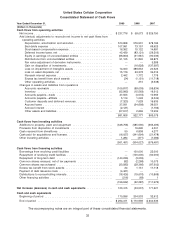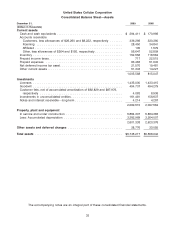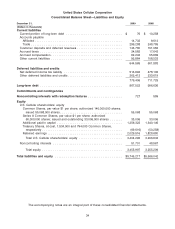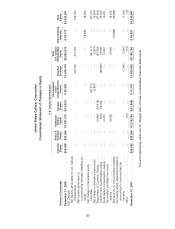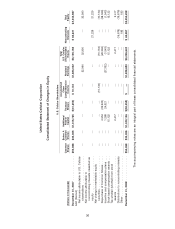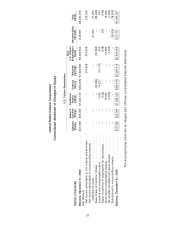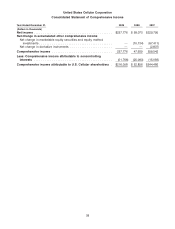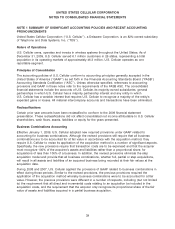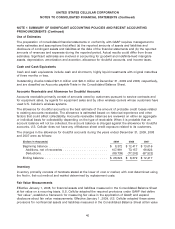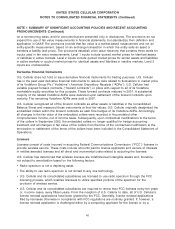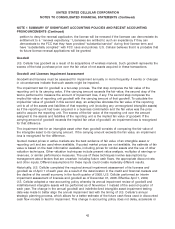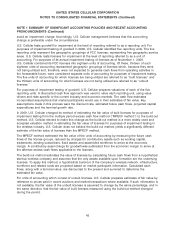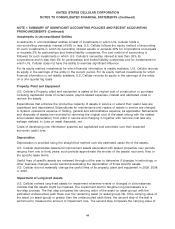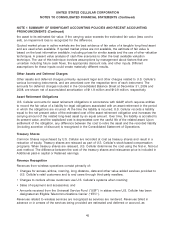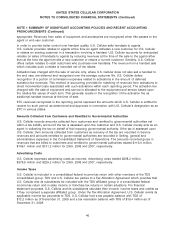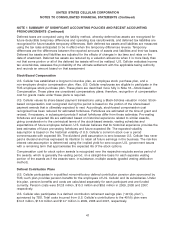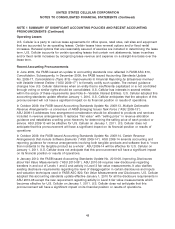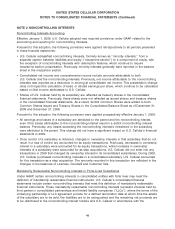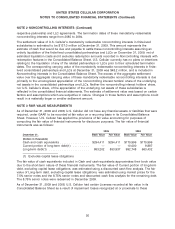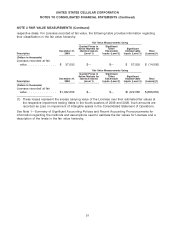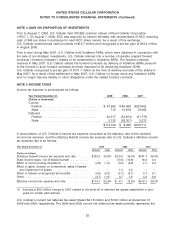US Cellular 2009 Annual Report Download - page 50
Download and view the complete annual report
Please find page 50 of the 2009 US Cellular annual report below. You can navigate through the pages in the report by either clicking on the pages listed below, or by using the keyword search tool below to find specific information within the annual report.UNITED STATES CELLULAR CORPORATION
NOTES TO CONSOLIDATED FINANCIAL STATEMENTS (Continued)
NOTE 1 SUMMARY OF SIGNIFICANT ACCOUNTING POLICIES AND RECENT ACCOUNTING
PRONOUNCEMENTS (Continued)
petition to deny the renewal application, the license will be renewed if the licensee can demonstrate its
entitlement to a ‘‘renewal expectancy.’’ Licensees are entitled to such an expectancy if they can
demonstrate to the FCC that they have provided ‘‘substantial service’’ during their license term and
have ‘‘substantially complied’’ with FCC rules and policies. U.S. Cellular believes that it is probable that
its future license renewal applications will be granted.
Goodwill
U.S. Cellular has goodwill as a result of its acquisitions of wireless markets. Such goodwill represents the
excess of the total purchase price over the fair value of net assets acquired in these transactions.
Goodwill and Licenses Impairment Assessment
Goodwill and licenses must be assessed for impairment annually or more frequently if events or changes
in circumstances indicate that such assets might be impaired.
The impairment test for goodwill is a two-step process. The first step compares the fair value of the
reporting unit to its carrying value. If the carrying amount exceeds the fair value, the second step of the
test is performed to measure the amount of impairment loss, if any. The second step compares the
implied fair value of reporting unit goodwill with the carrying amount of that goodwill. To calculate the
implied fair value of goodwill in this second step, an enterprise allocates the fair value of the reporting
unit to all of the assets and liabilities of that reporting unit (including any unrecognized intangible assets)
as if the reporting unit had been acquired in a business combination and the fair value was the price
paid to acquire the reporting unit. The excess of the fair value of the reporting unit over the amount
assigned to the assets and liabilities of the reporting unit is the implied fair value of goodwill. If the
carrying amount of goodwill exceeds the implied fair value of goodwill, an impairment loss is recognized
for that difference.
The impairment test for an intangible asset other than goodwill consists of comparing the fair value of
the intangible asset to its carrying amount. If the carrying amount exceeds the fair value, an impairment
loss is recognized for the difference.
Quoted market prices in active markets are the best evidence of fair value of an intangible asset or
reporting unit and are used when available. If quoted market prices are not available, the estimate of fair
value is based on the best information available, including prices for similar assets and the use of other
valuation techniques. Other valuation techniques include present value analysis, multiples of earnings or
revenues, or similar performance measures. The use of these techniques involve assumptions by
management about factors that are uncertain including future cash flows, the appropriate discount rate,
and other inputs. Different assumptions for these inputs could create materially different results.
Historically, U.S. Cellular completed the required annual impairment assessment of its licenses and
goodwill as of April 1 of each year. As a result of the deterioration in the credit and financial markets and
the decline of the overall economy in the fourth quarter of 2008, U.S. Cellular performed an interim
impairment assessment of licenses and goodwill as of December 31, 2008. Effective April 1, 2009,
U.S. Cellular adopted a new accounting policy whereby its annual impairment review of goodwill and
indefinite-lived intangible assets will be performed as of November 1 instead of the second quarter of
each year. The change in the annual goodwill and indefinite-lived intangible asset impairment testing
date was made to better align the annual impairment test with the timing of U.S. Cellular’s annual
strategic planning process, which allows for a better estimate of the future cash flows used in discounted
cash flow models to test for impairment. This change in accounting policy does not delay, accelerate or
42


